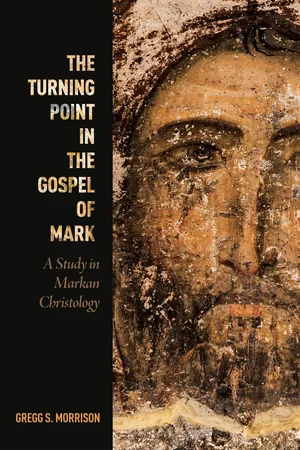![]()
1
Introduction
The question I will confront in this monograph is whether there is a turning point in the Gospel of Mark, that is, a pivot on which the entire narrative turns. A second and related question is: If such a pivot exists, then what is it? I believe there exists such a turning point in the Gospel of Mark and I hold it to be (broadly stated for now) in Mark’s middle section (8:22—10:52). I am not alone in this determination. Several scholars have observed a major climax and turning point in this section of the narrative. The second question—what precisely is the turning point?—is more difficult to answer and constitutes the burden of this book. If, as I will argue, the author constructed the Gospel with a decisive midpoint in mind, then how or in what way does the presentation of the turning point have an impact on the primary objective in writing, namely, the presentation or identity of Jesus? To put it another way, what is the relationship of the narrative’s turning point to Markan Christology?
In order to introduce this topic, I need to establish the context for determining the turning point in the Gospel, which will involve an examination of the structure or sequencing of the Gospel. After reviewing the proposals surrounding the various ways to outline the Gospel, I will examine the literary device of “turning point,” including how the question of gospel genre influences the discussion. Finally, I will provide a general overview of the plot of Mark’s Gospel, which will serve to introduce my proposal for the identification of Mark’s turning point.
The Structure of Mark’s Gospel
Interpreters interested in the structure of Mark’s Gospel have searched diligently for a coherent organizing principle in order to make sense of the narrative. Coming up with a conclusive outline or structure to the Gospel of Mark is difficult. One reason may be the seemingly disjunctive manner in which Mark assembled the materials at his disposal. Eusebius, for example, says that Papias claimed that (according to “the Presbyter”) Mark did not arrange the stories of Jesus in any particular order. Toward the end of the nineteenth century, Martin Kähler insisted that all the Gospels are “passion narratives with extended introductions.” Accordingly, scholarly opinion regarding the structure of the Gospel abound. While it is possible to oversimplify matters, the Gospel of Mark has generally been outlined in one of four ways: (1) topographically, along geographic movements in the Gospel; (2) thematically, highlighting a particular theme or the development of a theme such as Christology, discipleship, or faith; (3) topically, with Jesus’ teaching and healing ministry as the first major section and Jesus’ death and resurrection as the second; or (4) rhetorically, seeking some literary or persuasive device by which to distinguish the material.
Topographical Outlines
One of the first commentators of Mark’s Gospel in the twentieth century, Benjamin W. Bacon, divides the material topographically. Simply stated, he sees two major divisions of material: Part I relates to Jesus’ Galilean ministry (1:1—8:26) and Part II concerns Jesus’ Judean ministry (8:27—16:8). More recently, James R. Edwards shares the view of Bacon by stating that the narrative falls naturally into the same two halves. Vincent Taylor expands this twofold structure into six major divisions (after a prologue) in his outline of the Gospel: (1) the Galilean ministry (1:14—3:6); (2) the height of the Galilean ministry (3:7—6:13); (3) the ministry beyond Galilee (6:14—8:26); (4) Caesarea Philippi and the journey to Jerusalem (8:27—10:52); (5) the ministry in Jerusalem (11:1—13:37); (6) the passion and resurrection narrative (14:1—16:8). Many other commentators use topography as a means of examining the makeup of the Gospel.
Using topography as the signal feature in developing a Markan outline is not, however, without problems, especially within the portrayal of Jesus’ Galilean ministry (1:14—8:26). For example, in the so-called parable chapter (Mark 4), Jesus teaches in a boat alongside the sea (4:1–9). In 4:10, when he was alone, those around him with the T...
